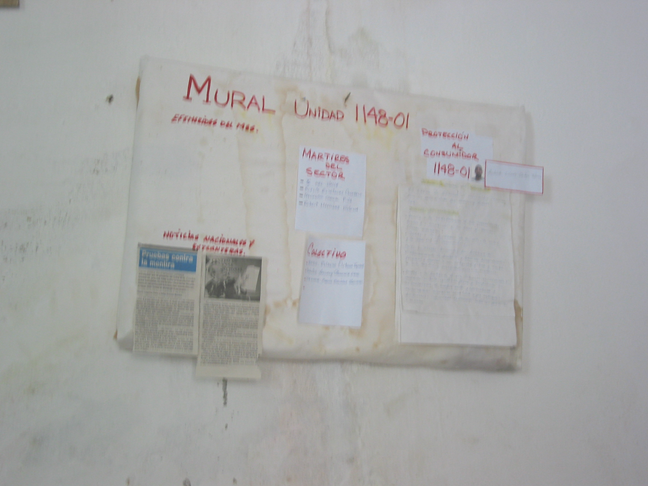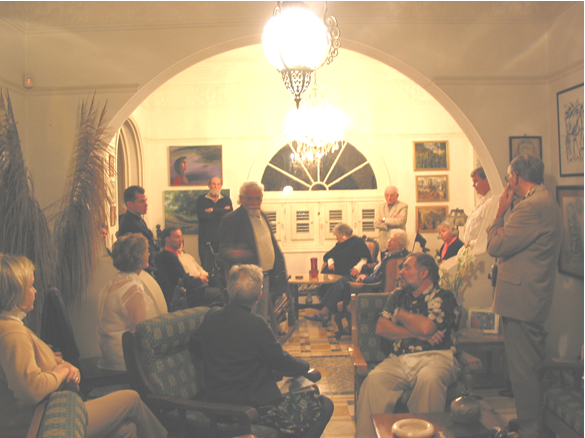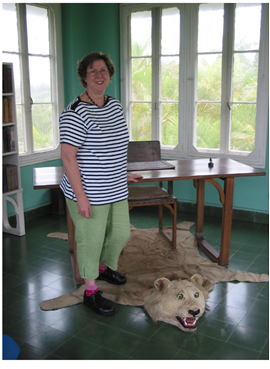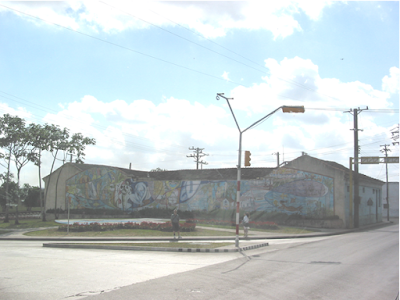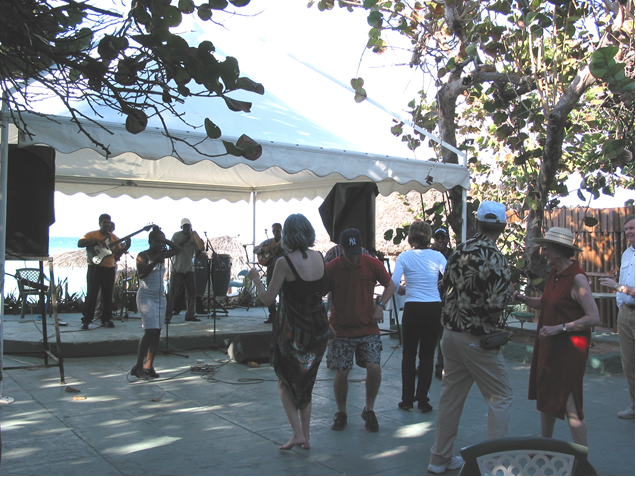In January 2003, the Commonwealth Club travel program took 35 travelers to Cuba on a cultural exchange program. We flew directly to Havana legally on the U.S. government license. Some of our group began the journey in Los Angeles, some in Miami. Our group leader was Wayne Smith, who was recognized for many years as the State Department’s leading expert on Cuba; he was serving there when Castro swept into power on January 1, 1959. After his 25 years in the U.S. Foreign Service, he was a professor of Latin Ameridan studies at Johns Hopkins University. Smith’s many contacts gave our group a terrific opportunity to see not only the touristic version of Cuba, but some behind-the-scenes opportunities such as meeting with dissidents. The Cuban people are fantastic: welcoming, lively, and for the most part stoic about the situation there.
Unlike
many of my “Adventures” blogs, this one is organized not on a day-to-day basis,
but by topics.
What’s
the first thing I noticed about Havana?
Probably the poignancy of a beautiful city, fallen into decay…..
A whole nation, arrested in time, captive to a philosophy that simply DOES NOT WORK.
Perhaps the most iconic photos you see (every visitor there has taken one of these types of photos) is of the old cars. New cars are practically impossible for the Cubans to buy and so they continue to repair, repair and repair again the cars that were on the island when Castro came to power. You see these cars everywhere, and they are favorites of tourists for transportation.
And
now a look around Havana:
The Plaza of San Francisco, anchored by the beautiful old church. Horse carriages wait here to transport tourists through Havana Viejo (old Havana).
If
you turn 90 degrees right, you see the other side of the plaza – buildings held
up with scaffolding, waiting for renovation.
These tenants are lucky because they live in an important tourist area
- many old buildings just crumble down
around the inhabitants, with dozens of lives quietly lost each week.
A
few blocks walk takes you to another plaza with colonnades buildings
surrounding a spacious open area – this was the market plaza during the Colonial
period, Plaza Viejo.
Tourism
is a major part of Cuba’s economy after the so-called “Special Period” (1991-2000) that
commenced when the Russians abandoned their support of the Cuban economy. To generate the dollars, Old Havana is
getting prettied up.
This
is probably the most evocative photo of the trip. Cuba is pinning its hopes on tourism… and the
potential for the future that the USA will drop its travel ban.
Once
the hardhats have done their job, this is the result! The blue building houses the Café Beny More,
a popular tourist restaurant.
Secondhand book dealers give ambiance to the Plaza de Armas on Sundays, and street entertainers add another fun dimension. This is the oldest plaza in Havana, originally laid out in 1519. On one side of the plaza is the Museum of the City of Havana – we had only time to peek in, but not time to visit.
The
Plaza de Cathedral is an excellent example of 18th century
architecture. A popular restaurant, the El
Patio Restaurant, attracts a lot of activity to this beautiful plaza.
Knowing
the tourists will come, this lady hams it up for dollars. Dollars, dollars, dollars. The average Cuban needs them to obtain
anything more than just the bare necessities of life.
The
Capitolio dominates Havana’s skyline.
Built in the 1920’s and modeled after the Congress building in
Washington DC, after the Revolution it became the headquarters of the Academy
of Sciences.
Parque
Central
is the social epicenter of Habana Vieja.
The famous old cars of Havana wait for fares from well-heeled tourists
staying at the Central Park Hotel. (Note
for the future: a hotel to try, on the
other side of the square, is the Hotel Telegrafo)
A
little way out of the tourist areas, but still part of Havana, these dismal
looking apartment buildings reflect the function structure of the Russian
engineers who designed them. Block after
dreary block, a sad reminder of this time in Cuba’s history….
Looking
over Havana, a huge statute of Christ is a center of a park to which many Cuban
families come for picnics. Cuba certainly
needs all the help it can get!
Transportation
for Tourists: everything from the CoCo
taxis with fantastic shapes cobbled onto motorcycle frames (approx. $2 for
almost any distance), to new European cars with English-speaking drivers, to
the guys with the old cars that can be hired for $20 per hour…
…for
the average Habanero, the cheapest available transportation is the “Camel Bus”,
a Castro innovation during the Special Period – a semi-truck pulls two platforms,
onto which something like mobile homes have been attached, with a low-roofed transition
in between. Packed with 300-400 people
on a hot day…. imagine…
Here is what was available on January 31, 2003, at the store in Cojimar, just down the street from the La Terressa restaurant that was frequented by Hemingway, and now, tourists…
The
clerk weighs out rice, beans, flour. No
need really for a fancy cash register….
Outside,
an independent businessman sells yams, chiles, tomatoes, bananas. Pleased to be asked to have his picture
taken, he just handed me a banana, gratis.
The handful of lollipops I gave him for “los ninos” went quickly into
his market sacks, with effusive thanks.
Fresh
meat? Not really on the average menu for
Cubans. When available, here is where
you’d buy it:
Contrast
this to the dollar-only supermarkets in Central Havana – beverages from all
over the world…. And foods too….
MUSIC AND HAPPY TIMES
We
were lucky to see a performance of the Afro-American All Stars, with Amadito
Valdez (an original member of Buena Vista Social Club) sitting on
percussion.
I hung back after the performance and gifted
Sr. Valdez with a copy of Matt Keck’s new CD “Self Made”.
The
nightclub at the Hotel Nacional, where we stayed, is supposedly the
forerunner of the Las Vegas shows.
T&A and everything, including acrobatic acts, blackface minstrels
(not exactly politically appropriate…), etc
Inside
the fabulous re-done building, the Amigos del Bey café taverna serves an
excellent lunch, and the entertainment of local band Septeto Sonido Son,
playing music in the Beny More tradition, made it lively. A samba-dancing demonstration was also
enticing.
We
had a noon meal of paella at this “taberna” restaurant in Havana Viejo, El Meson de la Flota.
This
establishment also rents rooms to tourists.
If you do stay at de la Flota, be prepared for lots of loud music – and the
taps of flamenco dancers at the shows!
Up
at the old fort La Cabana looking over Havana harbor, the tradition of
shooting the cannon at 9 p.m. every night still goes on. In Colonial days, this heralded the raising
of the chain across the harbor, keeping the citizens safe from pirate ships
entering during the night. Preceding
this ceremony, the group dined at a paladar, a private restaurant operated from
a local home.
 |
| The fort |
After
the ceremony, a local band, 5PA’8, set up in the outdoor plaza, and got
everyone dancing.
Other restaurants we enjoyed: Le Chansonnier – a beautiful little restaurant in Vedado section.
Our group was fortunate to stay at the famous Hotel Nacional de Cuba, a historic Spanish eclectic style hotel which opened in 1930. Located on the sea front of Vedado district, it stands on Taganana Hill, offering commanding views of the sea and the city. When it was first opened, it was operated by the manager of the famous NYC Plaza Hotel, as Cuba was a prime tourist destination then.
I’m including a lot of history in the paragraphs below, because in a sense, the history of the hotel is the history of Cuba.
The hotel (thanks Wikipedia)
has quite a history: “ In 1933, after Fulgencio Batista's September 4th coup against the
transitional government, The National Hotel was the residence of Sumner Welles, a special envoy sent by U. S. President Franklin D. Roosevelt to
mediate the crisis. Soon after, on October 2–3, 1933, it was the site of a
bloody siege that would become known as the Battle of the
Hotel Nacional of Cuba. The conflict pitted officers of the Cuban
army, holed up in the hotel, who had been instrumental in the overthrow
of Gerardo Machado but
opposed Batista, against the non-commissioned officers and other ranks of the
Cuban army, who supported Batista. Their successful assault on the hotel left
over forty combatants dead and caused extensive damage to the building,
including shell and bullet holes.
The National Hotel was restored soon
after and reopened. In 1939, it was renamed Hotel Nacional de Cuba.
Beginning on December
20, 1946 the hotel hosted the Havana Conference, an infamous mob summit run by Lucky Luciano and Meyer Lansky and
attended by Santo Trafficante
Jr., Frank Costello, Albert Anastasia, Vito Genovese and many others. Francis Ford Coppola dramatized the conference in his film The Godfather Part II.
Fidel Castro nationalized the hotel on March 20, 1960 and
finally closed the hotel’s casino in October 1960, almost two years after his
overthrow of Batista.
During the Cuban Missile Crisis,
anti-aircraft guns were set up on the site of the Santa Clara Battery and
an extensive series of tunnels were built under the property, which are now
open to the public on guided tours.
After years of neglect due to the
reduction in tourism following the revolution, the hotel was mainly used to
accommodate visiting diplomats and foreign government officials. The collapse of the USSR in
1991 forced the Cuban communist party,
anxious for foreign exchange reserves,
to reopen Cuba to tourists.”
There are many historic hotels in Havana. The Hotel Ambos Mundos in La Habana Vieja on Calle del Obispo Esquina a Mercaderes, is where Hemingway lived in a room on the 5th floor when he wrote “For Whom the Bell Tolls”. There is a little Hemingway museum in the hotel, and the room price in 2003 was $130 for a single room. I was impressed by this beautiful hotel, which had a wonderful lobby area. Easy to imagine Hemingway having a drink there!
Santo Angel, a restaurant on one side of Plaza Vieja, served a delicious shrimp & lobster lunch. We had a kitchen tour!
Other restaurants of note: El Aljibe at 7th Ave & 16th
Street in the Miramar neighborhood.
Famous for its chicken, rice & beans. I met documentary-maker and activist Margaret
(Peggy) Gilpin there; she is a friend of a friend. When Peggy is not in Havana as an
international journalist, she is a psychotherapist in NYC. As recently as 2020, Peggy was still actively
writing and lobbying via an organization, the International US-Cuba Normalization
Committee Coalition. Peggy was quite an
interesting woman to meet and talk to, and we continued keeping in touch for
several years. More about her: From 1970 to
the1990s, she was president of U.S.-Cuba Health Exchange (U.S.C.H.E.), which
spearheaded medical and scientific interchange between Cuba and the U.S.
She authored many articles about the Cuban health-care system and seminal
articles about the Cuban family-medicine program. In the '90s, she turned
to documentary filmmaking. Her best-known documentary, "Mariposas en el
Andamio/Buttterflies on the Scaffold," (1996) looks at drag and being gay
in Cuba.
SPECIAL VISITS AND
EDUCATIONAL OPPORTUNITIES
We met Mr. Rafael Dausa,
Director of the North American Bureau at Cuba’s Foreign Affairs Ministry. Prior to that, we had a briefing at the US
Interest section.
We went to a
presentation by Dr. Victoria Reyes, Director of Science at the Ministry of
Education, and visited a school for visually impaired children at the Ciudad Libertad
Complex.
We went to the Ministry
of Health and heard a presentation on the health care system given by Dr. A.
Pantoja.
We heard a lecture and
snippets of Cuban music at the Musicology Institute, and mets its director, Dr.
Olavo Alane Rodriquez.
We had a meeting with 4
dissidents, all of whom had been jailed for their political beliefs, the least
severe sentence of which was 5 years in prison. In 2003, there were still 200 political
prisoners in Cuba. The dissidents, once
released are ignored by Castro, and survive on allotments from Amnesty
International.
LITERATURE, ART, AND ARTISTS
Not to be missed: Museo Nacional Palacia de Bellas Artes
(National Art Museum).
Wayne Smith’s old friend Pablo Armando
Fernandez, invited us to his home, where he signed books of his poetry. In 2001 he had published this one which he
signed for us: “Parables: Selected
Poems.” Wikipedia’s summary is: Pablo Armando Fernández was a Cuban poet, novelist,
essayist and playwright. In 1996, he was awarded the National Prize for
Literature, Cuba's national literary award and most important award of its
type. Born in the Oriente Province, Fernández lived in the United States from
1945 to 1959. More about this
important Cuban writer (deceased in 2021) at https://walterlippmann.com/pablo-armando-fernandez-has-died/
We visited Raul Corrales, whose books of photos from
The Revoluation and photos of Hemingway in Cojimar are legendary. “I was just a simple press photographer,” he
said. In 2003, he was 78 years old and
reitred, and he told our group about how Ernesto invited him fishing.
I’m always curious about how people live, particularly creative folks…. The things they collect, their daily routines. From my scrapbook of this trip, these two photos are in a batch called “Images from an artist’s home”….
Seeing beauty where others see discards, the craftsmen of
Cuba make toys from old beverage cans, and papier mache images of Cuba’s famous
old cars.
Taking a break from the souvenir stand, the vendors engage in
an intense game of dominos.
On
the Malecon, an artist sets up his display (one among many). Here he showcases a silkscreen frame-capture
from the Buena Vista Social Club movie.
In
the Feria near the Plaza de la Cathedral, another series of artist stalls featuring
oil paintings, watercolors and lithos.
The artist we spoke to here is Angal Alonso, who proudly noted that his
work has been in galleries in Sweden and Los Angeles.
Probably
the most beautiful sculpture is in the Cemeterio de Colon, or the Necropolis
Cristobal Colon, renowned worldwide for its flamboyant mausoleums, tombs,
etc. It covers 56 hectares (almost 140
acres), and dates from the 1870’s, originally laid out by social status and
open only to nobles, who competed to build the most elaborate tombs!
HEMINGWAY
Hemingway loved Cuba, and did some of his best writing – and living - here. He bought this estate, Finca Vigia, in the town of San Francisco de Paula.
For
a small consideration, the room guard in Hemingway’s 3-story “room with a view”,
will let you stand at Hemingway’s desk and wait for his Muse.
Oh,
who could resist? There are no postcards
of Hemingway’s bathroom, and it is just plain terrific that he had a bidet!
Across
the street, La Terressa restaurant was the site of many of Hemingway’s
meals. Modernized since then, of course,
and geared for the tourist trade, the restaurant boasts dozens of Raul Corrales’
prints on the wall – wonder if the restaurant owners know that $20,000 of photo
prints are within easy reach of diners?
Hemingway’s
well-known boat, Pilar, was docked at the nearby fishing village of Cojimar…but
it is preserved for tourists near his estate.
Cojimar
itself has seen better times. A beautiful
mansion is now the home of several families, who have used the former lawn to
create terraced vegetable gardens. Need
a taxi? How about this beauty?
Artistic
expression
is everywhere in Cuba. Here we see it on
the wall of a building on the roadside, as we take the two hour drive to
Varadero beach.
Varadero
Beach
Varadero beach is a major tourist destination. It is 140 km (85 miles) from Havana.
Looking
out from the roof vantage point of the former DuPont mansion, Xanadu, one sees
the golf course built at great expense by Castro to attract tourists. If you stay at Xanadu (now a hotel), greens
fees are free and unlimited (at least that was the case in 2003…).
From
the veranda of Xanadu, the pristine beach stretches out.
In
the upstairs bar of Xanadu, you too can be in a place that’s like a movie set.
Luncheon on the veranda was exquisite, with food arranged for the eye as well as the palate.
We drove past other nice-looking hotels: Arenas Blancas (5-star), Solimar, Melia group’s Les Americas. No wonder Varadero beach is such a tourist destination. Too bad it is so difficult for US citizens to travel there, requiring all kinds of visas, and of course you can’t use US dollar denominated credit or bank cards.
Varadero town itself is geared for the economy travelers – lots of students are attracted by the theme bars.
You
can get a massage on the Varadero town beach…
You
can buy souvenirs from the vendors on the beach…..
You
can eat well and cheaply, and dance to the band on the outdoor patio too!
What
this blog does not include is commentary about the visit to a cigar factor
where 700 workers toiled on the seven-floor factory and each have
responsibility for producing 100 cigars by hand every day. They are paid the equivalent (in 2003) of
$10-15 dollars per month plus they have the right to walk out each day with two
cigars in their pocket and one in their mouth.
We also visited a rum museum, housed in a charming colonial building, and learned about the history and process of rum production and we tasted some of its products.
With
this wonderful visit behind me, in
December 2003 my sons Martin and Matthew and I traveled back to Cuba (via
Vancouver) with a humanitarian visa to carry medical supplies to an association
of the disabled in Havana, and then enjoyed 5 days at Varadero. That’s where Matt met Sofia on the 30th of December 2003 (they married
in 2005); she was there with her mother
for a holiday, having traveled from their home in Guatemala City. So many Central Americans enjoy Cuba for vacations,
as do Canadians and Europeans. Maybe
someday the USA government will permit easy travel to Cuba again without the
need for special cultural, educational or humanitarian-worker visas. Hope so.

















